Drone Magnetic and Time Domain Electromagnetic Exploration in Metamorphic Formations: Tool for the Identification of Strategic Sites for Aquifer Exploitation
Abstract
:1. Introduction
2. Geological and Hydrogeological Context
2.1. Geological Context
2.2. Hydrogeological Context
3. Materials and Methods
3.1. Site Conditions
3.2. Platform and Flight Planning
3.3. Magnetometry
3.4. TDEM
3.5. Data Processing
4. Results
4.1. Total Magnetic Field and Reduction to Pole
4.2. D Inversion Model
4.3. TDEM
4.4. Geological Interpretation, Site Location and Drilling Results
5. Conclusions
Author Contributions
Funding
Institutional Review Board Statement
Informed Consent Statement
Data Availability Statement
Conflicts of Interest
References
- D’Odorico, P.; Chicarelli, D.D.; Rosa, L.; Bini, A.; Zilberman, D.; Rulli, M.C. The global value of water in agriculture. Proc. Natl. Acad. Sci. USA 2020, 117, 21985–21993. [Google Scholar] [CrossRef] [PubMed]
- Basso, B.; Kendall, A.D.; Hyndman, D.W. The future of agriculture over the Ogallala Aquifer: Solutions to grow crops more efficiently with limited water. Earth’s Future 2013, 1, 39–41. [Google Scholar] [CrossRef]
- Smidt, S.J.; Haacker, E.M.K.; Kendall, A.D.; Deines, J.M.; Pei, L.; Cotterman, K.A.; Li, H.; Liu, X.; Basso, B.; Hyndman, D.W. Complex water management in modern agriculture: Trends in the water-energy-food nexus over the High Plains Aquifer. Sci. Total Environ. 2016, 566–567, 988–1001. [Google Scholar] [CrossRef] [PubMed]
- Othman, A.; Sultan, M.; Becker, R.; Alsefry, S.; Alharbi, T.; Gebremichael, E.; Alharbi, H.; Abdelmohsen, K. Use of Geophysical and Remote Sensing Data for Assessment of Aquifer Depletion and Related Land Deformation. Surv. Geophys. 2018, 39, 543–566. [Google Scholar] [CrossRef]
- Calderón Palma, H.; Bentley, L.R. A regional-scale groundwater flow model for the Leon-Chinandega aquifer, Nicaragua. Hydrogeol. J. 2007, 15, 1457–1472. [Google Scholar] [CrossRef]
- Rad, M.R.; Brozovic, N.; Foster, T.; Mieno, T. Effects of instantaneous groundwater availability on irrigated agriculture and implications for aquifer management. Resour. Energy Econ. 2020, 59, 101129. [Google Scholar] [CrossRef]
- Ofterdinger, U.; MacDonald, A.M.; Comte, J.C.; Young, M.E. Groundwater in fractured bedrock environments: Managing catchment and subsurface resources- an introduction. Geol. Soc. Lond. Spec. Publ. 2019, 479, 1–9. [Google Scholar] [CrossRef]
- Font Capó, J.; Vázquez Suñe, E.; Carrera, J.; Herms, I. Groundwater characterization of a heterogenous granitic rock massif for shallow tunneling. Geol. Acta Int. Earth Sci. J. 2012, 10, 395–408. Available online: https://dialnet.unirioja.es/servlet/articulo?codigo=4138023 (accessed on 17 August 2023).
- Gobashy, M.M.; Metwally, A.M.; Abdelazeem, M.; Soliman, K.S.; Abdelhalim, A. Geophysical Exploration of Shallow Groundwater Aquifers in Arid Regions: A Case Study of Siwa Oasis, Egypt. Nat. Resour. Res. 2021, 30, 3355–3384. [Google Scholar] [CrossRef]
- Nabighian, M.N.; Grauch, V.J.S.; Hansen, R.O.; LaFehr, T.R.; Li, Y.; Peirce, J.W.; Phillips, J.D.; Ruder, M.E. The historical development of the magnetic method in exploration. Geophysics 2005, 70, 33–61. [Google Scholar] [CrossRef]
- IGME MAGNA. Geological and Mining Institute of Spain (IGME). Hoja de Usagre (855). In Mapa Geológico de España (E. 1:50.000); Servicio de Publicaciones del Ministerio de Industria y Energía: Madrid, Spain, 1981. [Google Scholar]
- BD Puntos de Agua v2.0 IGME. Available online: https://info.igme.es/BDAguas/ (accessed on 19 August 2023).
- Hernandez-Lopez, D.; Felipe-Garcia, B.; Gonzalez-Aguilera, D.; Arias-Perez, B. An automatic approach to UAV flight planning and control for photogrammetric applications. Am. Soc. Photogramm. Remote Sens. 2013, 1, 87–98. [Google Scholar] [CrossRef]
- Elwaheidi, M. Geophysical Imaging of a Buried Tertiary Valley Aquifer in an Arid Region Using Time Domain Electromagnetic Method. J. Geosci. Environ. 2020, 8, 195–206. [Google Scholar] [CrossRef]
- Hamada, L.R.; Porsani, J.L.; Bortolozo, C.A.; Rangel, R.C. TDEM and VES soundings applied to a hydrogeological study in the central region of the Taubaté Basin, Brazil. First Break 2018, 36, 49–54. [Google Scholar] [CrossRef]
- Cunningham, M.; Samson, C.; Wood, A.; Cook, I. Aeromagnetic Surveying with a Rotary-Wing Unmanned Aircraft System: A Case Study from a Zinc Deposit in Nash Creek, New Brunswick, Canada. Pure Appl. Geophys. 2018, 175, 3145–3158. [Google Scholar] [CrossRef]
- Walter, C.A.; Braun, A.; Fotopoulos, G. Impact of three-dimensional attitude variations of an unmanned aerial vehicle magnetometry system on magnetic data quality. Geophys. Prospect. 2019, 67, 465–479. [Google Scholar] [CrossRef]
- Mu, Y.; Chen, L.; Xiao, Y. Small Signal Magnetic Compensation Method for UAV-Borne Vector Magnetometer System. IEEE Trans. Instrum. Meas. 2023, 72, 1–7. [Google Scholar] [CrossRef]
- Walter, C.A.; Braun, A.; Fotopoulos, G. High-resolution unmanned aerial vehicle aeromagnetic surveys for mineral exploration targets. Geophys. Prospect. 2020, 68, 334–349. [Google Scholar] [CrossRef]
- Zheng, Y.; Li, S.; Xing, K.; Zhang, X. Unmanned Aerial Vehicles for Magnetic Surveys: A Review on Platform Selection and Interference Suppression. Drones 2021, 5, 93. [Google Scholar] [CrossRef]
- Huerta, P.; Carrasco-García, P.; Armenteros, I.; Recio, C.; Carrasco-García, J.; Rodríguez-Jiménez, E. TDEM Soundings as a Tool to Determine Seasonal Variations of Groundwater Salinity (Villafáfila Lakes, Spain). Water 2022, 14, 2402. [Google Scholar] [CrossRef]
- Nieto, I.M.; Carrasco García, P.; Sáez Blázquez, C.; Farfán Martín, A.; González-Aguilera, D.; Carrasco García, J. Geophysical Prospecting for Geothermal Resources in the South of the Duero Basin (Spain). Energies 2020, 13, 5397. [Google Scholar] [CrossRef]
- Sheriff, R.E. Geophysical Methods, 1st ed.; Prentice Hall: Englewood Cliffs, NJ, USA, 1989. [Google Scholar]
- Porras, D.; Carrasco, J.; Carrasco, P.; Alfageme, S.; Gonzalez-Aguilera, D.; Lopez Guijarro, R. Drone Magnetometry in Mining Research. An Application in the Study of Triassic Cu-Co-Ni Mineralizations in the Estancias Mountain Range, Almería (Spain). Drones 2021, 5, 151. [Google Scholar] [CrossRef]
- Carrasco-García, J.; Porras-Sanchiz, D.; Carrasco-García, P.; Herrero-Pacheco, J.L.; Martín-Nieto, I.; Benito-Herrero, J.M.; Huerta-Hurtado, P. Time-Domain Electromagnetics as a Geophysical Tool in Hydrogeological Exploitation Projects in Mesozoic Formations. Appl. Sci. 2022, 12, 8655. [Google Scholar] [CrossRef]
- Subasinghe, N.D.; Charles, W.K.D.G.D.R.; De Silva, S.N. Analytical Signal and Reduction to Pole Interpretation of Total Magnetic Field Data at Eppawala Phosphate Deposit. J. Geosci. Environ. Prot. 2014, 2, 3. [Google Scholar] [CrossRef]
- Munazyi, D.; Suparman, R.; Abiyudo, R. Application of Magnetic Method (Reduced to Pole and Analytic Signal) to Extract Specific Geology Information (Young Lava, Alteration and Quarternary Older Rock). Case Study: Mount Lamongan. In Proceedings of the 4th Indonesia International Geothermal Convention & Exhibition 2016, Cendrawasih Hall—Jakarta Convention Center, Jakarta, Indonesia, 10–12 August 2016. [Google Scholar]
- Telford, W.M.; Geldart, L.P.; Sheriff, R.E. Applied Geophysics; Cambridge University Press: Cambridge, UK, 1990. [Google Scholar]
- Clark, D.A.; Emerson, D.W. Notes on Rock Magnetization Characteristics in Applied Geophysical Studies. Explor. Geophys. 1991, 22, 547–555. [Google Scholar] [CrossRef]
- MacLeod, I.N.; Ellis, R.G. Magnetic Vector Inversion, a Simple Approach to the Challenge of Varying Direction of Rock Magnetization. Australian Society of Exploration Geophysicists, Extended Abstracts. 2013, pp. 1–4, Melbourne. Available online: https://www.semanticscholar.org/paper/Magnetic-Vector-Inversion-%2C-a-simple-approach-to-of-Macleod-Ellis/9cd186fe7e6843baeb43c706d80fc64ffed3109a (accessed on 1 December 2021).
- Porras, D.; Carrasco, J.; Carrasco, P.; Herrero-Pacheco, J.L. Deep TDEM Study for Structural and Mining Purposes: A Case Study of the Barbastro Saline-Evaporitic Formation, Spain. Appl. Sci. 2023, 13, 6385. [Google Scholar] [CrossRef]
- Mendoza, R.; Rey, J.; Martínez, J.; Hidalgo, M.C.; Sandoval, S.S. Geophysical characterisation of geologic features with mining implications from ERT, TDEM and seismic reflection (Mining District of Linares-La Carolina, Spain). Ore Geol. Rev. 2021, 139, 104581. [Google Scholar] [CrossRef]

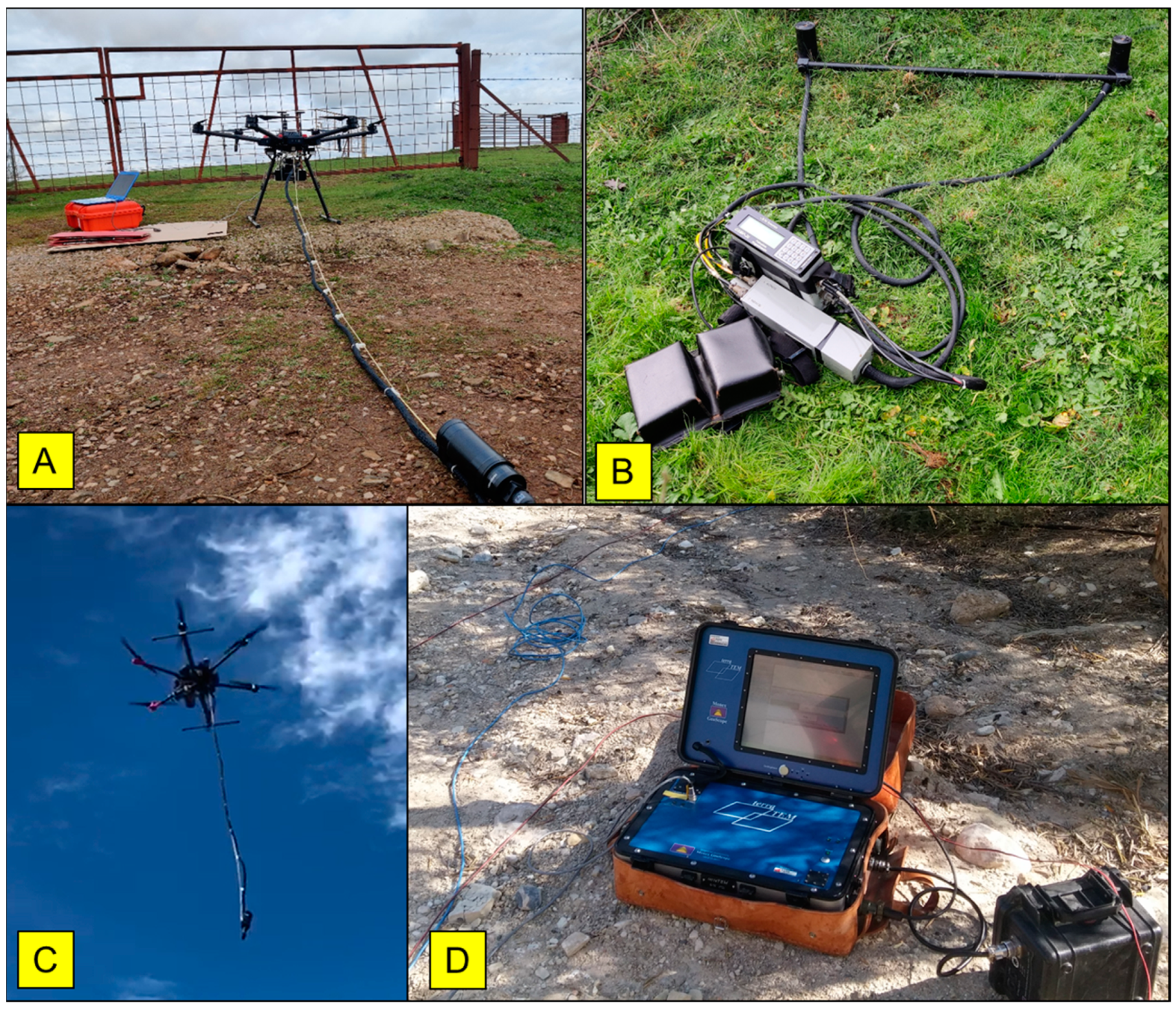
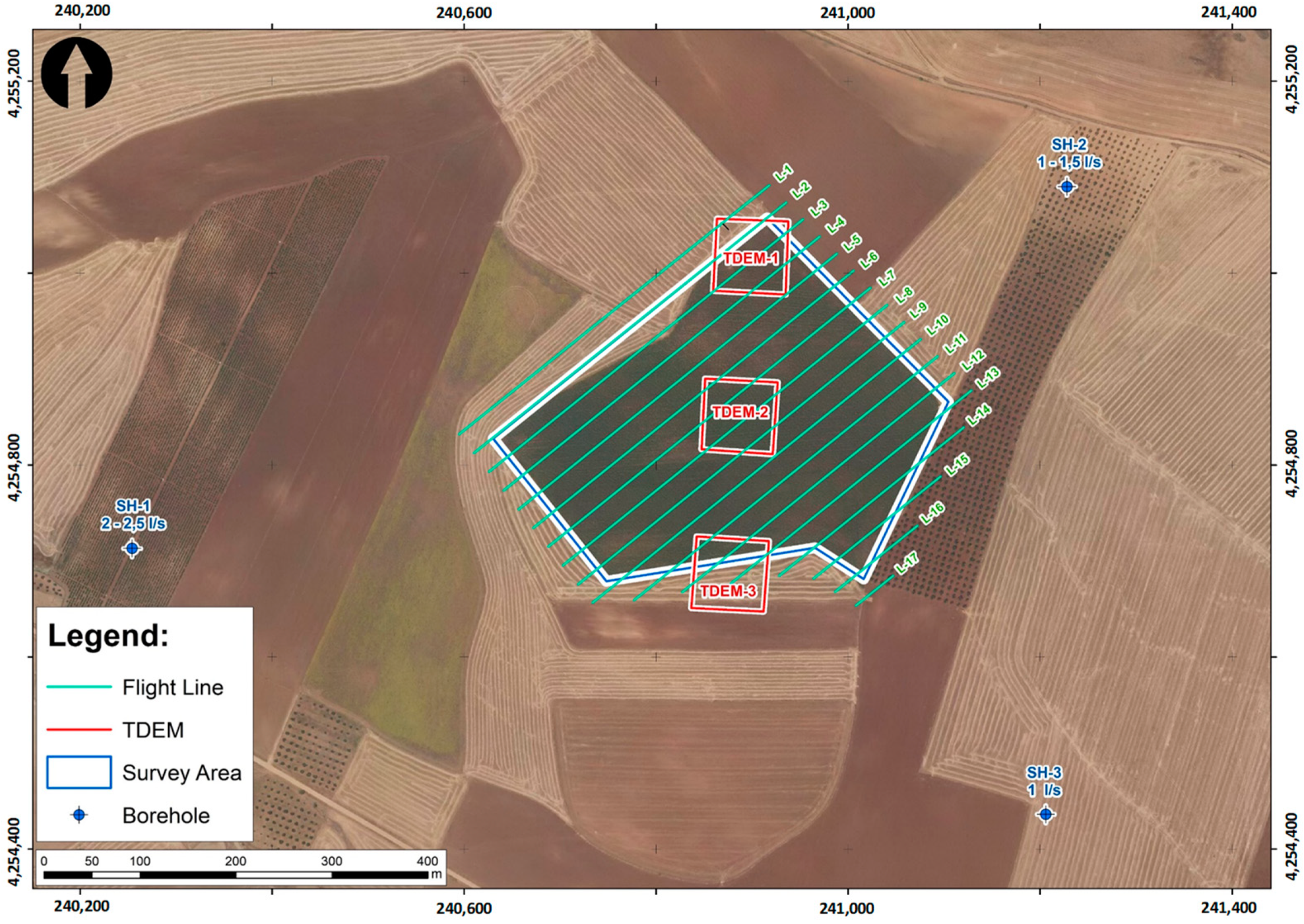
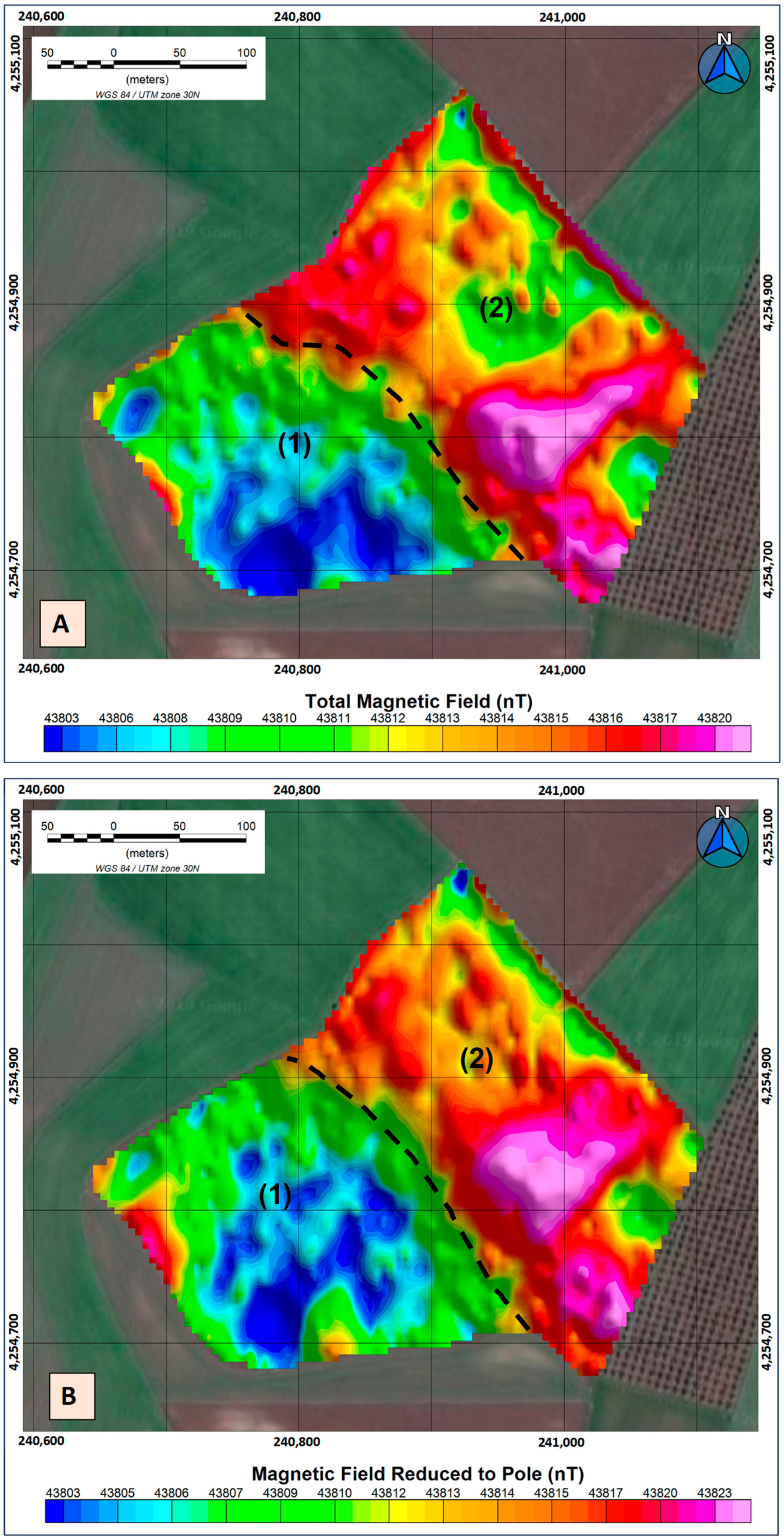
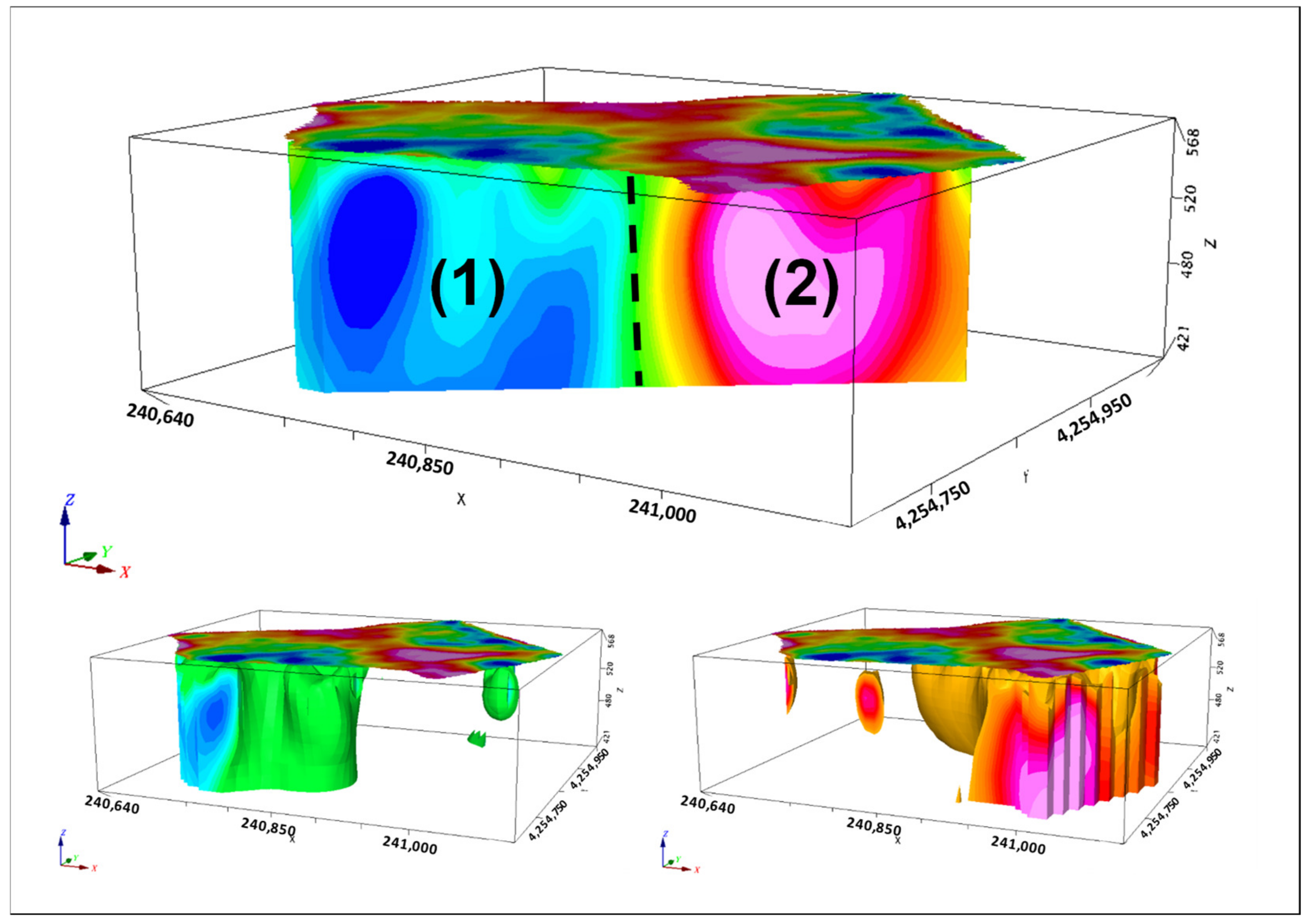
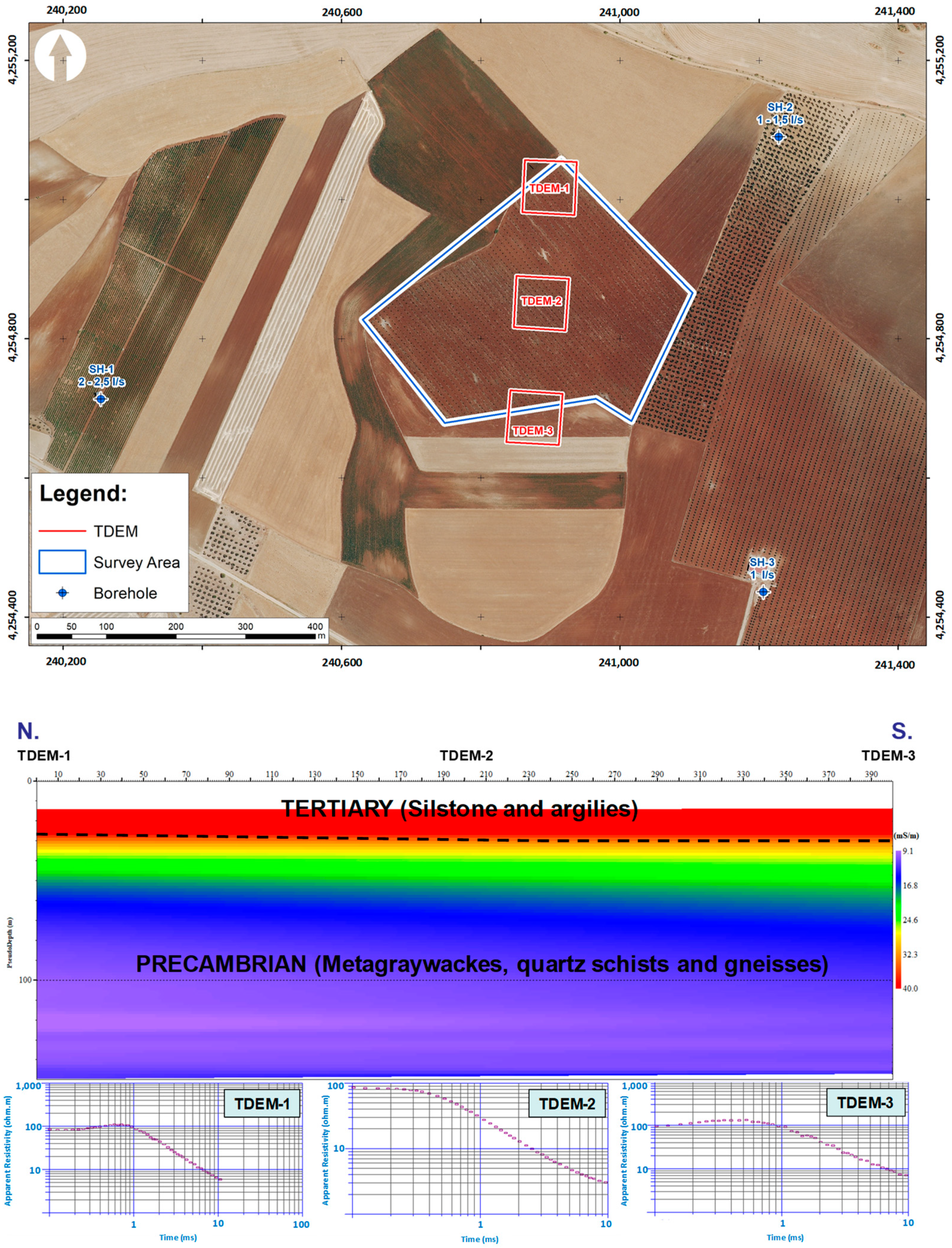



Disclaimer/Publisher’s Note: The statements, opinions and data contained in all publications are solely those of the individual author(s) and contributor(s) and not of MDPI and/or the editor(s). MDPI and/or the editor(s) disclaim responsibility for any injury to people or property resulting from any ideas, methods, instructions or products referred to in the content. |
© 2023 by the authors. Licensee MDPI, Basel, Switzerland. This article is an open access article distributed under the terms and conditions of the Creative Commons Attribution (CC BY) license (https://creativecommons.org/licenses/by/4.0/).
Share and Cite
García, J.C.; García, P.C.; Sanchiz, D.P.; Nieto, I.M.; Blázquez, C.S.; Hurtado, P.H. Drone Magnetic and Time Domain Electromagnetic Exploration in Metamorphic Formations: Tool for the Identification of Strategic Sites for Aquifer Exploitation. Appl. Sci. 2023, 13, 10949. https://doi.org/10.3390/app131910949
García JC, García PC, Sanchiz DP, Nieto IM, Blázquez CS, Hurtado PH. Drone Magnetic and Time Domain Electromagnetic Exploration in Metamorphic Formations: Tool for the Identification of Strategic Sites for Aquifer Exploitation. Applied Sciences. 2023; 13(19):10949. https://doi.org/10.3390/app131910949
Chicago/Turabian StyleGarcía, Javier Carrasco, Pedro Carrasco García, Daniel Porras Sanchiz, Ignacio Martín Nieto, Cristina Sáez Blázquez, and Pedro Huerta Hurtado. 2023. "Drone Magnetic and Time Domain Electromagnetic Exploration in Metamorphic Formations: Tool for the Identification of Strategic Sites for Aquifer Exploitation" Applied Sciences 13, no. 19: 10949. https://doi.org/10.3390/app131910949
APA StyleGarcía, J. C., García, P. C., Sanchiz, D. P., Nieto, I. M., Blázquez, C. S., & Hurtado, P. H. (2023). Drone Magnetic and Time Domain Electromagnetic Exploration in Metamorphic Formations: Tool for the Identification of Strategic Sites for Aquifer Exploitation. Applied Sciences, 13(19), 10949. https://doi.org/10.3390/app131910949






